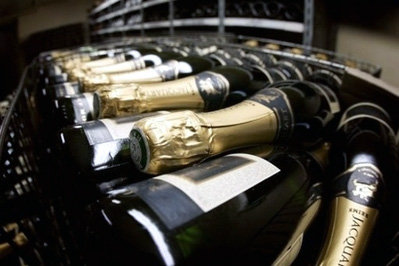AFP
Feb 29, 2008
Champagne once chucked into rivers, oldtimers say
AFP
Feb 29, 2008
EPERNAY, France, Feb 29, 2008 (AFP) - The reason they put bubbles in it, wine-growers from Bordeaux and Burgundy have been heard to say, is because the wine is no good.
But with 338 million bottles sold last year and exports up 5.3 percent, champagne has come far from humble times.
 Photo : Olivier Laban-Mattei/AFP |
Jacqueline Salvatori, 80-year-old owner of a small champagne shop in Epernay, the heart of the champagne region, is one who remembers tales of her grandparents emptying unwanted champagne into local rivers.
"My grandparents were part of a revolution against the buyers in 1911, because they would not buy their wine," said Salvatori. "In those days they used to empty their vats into streams," she said.
Born in 1928, Salvatori in one lifetime has seen the region go from semi-misery to easy money. "My sales have been constantly increasing for several years," she said. "In 2007 they were up by 13 percent".
Asked the reason for the turnaround, Salvatori says it is the result of a combination of increased commercial interest and improved wines.
"Things changed when the buyers began to take an interest in champagne, and then with the intervention of specialist wine-making consultants in the 1950s," she said.
The downside, she believes, is that now some top champagnes, in an effort to appeal to the widest possible public, have become too uniform.
-- Some 16,000 brands of champagne available --
The arrival of big businesses, such as LVMH, the world's top luxury group, or Remy Cointreau, in the 1990s also changed things. "Before it was more fair-play', more human, in terms of business relations," she said. Today, to get certain vintages, it is a more "quarrelsome" process, she said.
In her catalogue, Salvatori has more than 150 champagnes for sale from her shop, opened as a general store in 1952. Her only sales credo? "To sell what I love," she said, including, to please longtime customers, a few tins of preserves and some vegetables.
Since the 1970s however, the main focus has been champagne. "There used to be few champagne brands, today there are about 16,000," she said.
Salvatori, who sells everything from good value champagne to the most expensive, half bottles to magnums, has also seen the impact global market demand has had on the people who find their way to her shop.
"The first foreigners who came? The English," she said. "Today it is the Swedish who are the vintage connoisseurs, and who spend the most. The Italians and the Finnish also love champagne," as well as the Japanese, she said, who have been buying for the last 10 or 15 years.
Export figures released this week showed Britain still champagne's top market, followed by the US. In emerging markets, sales to Russia soared 41 percent while 30 percent to China.
Asked about retirement, Salvatori, who was recently awarded a gold medal by a the local Brotherhood of Champagne Growers, said she didn't think so. "I love champagne too much."
by Jordane Bertrand
Copyright © 2024 AFP. All rights reserved. All information displayed in this section (dispatches, photographs, logos) are protected by intellectual property rights owned by Agence France-Presse. As a consequence you may not copy, reproduce, modify, transmit, publish, display or in any way commercially exploit any of the contents of this section without the prior written consent of Agence France-Presses.

























